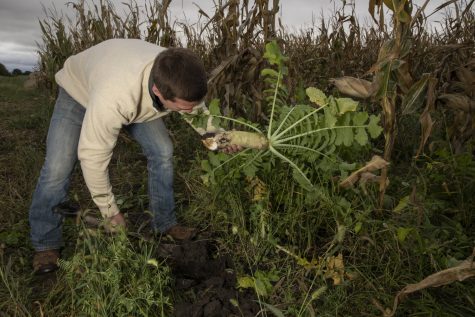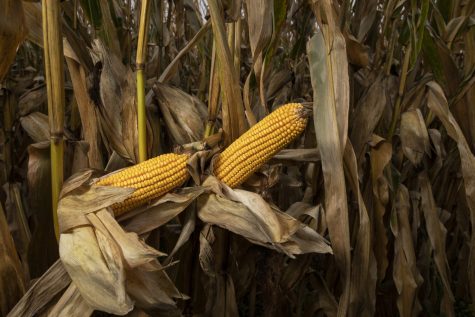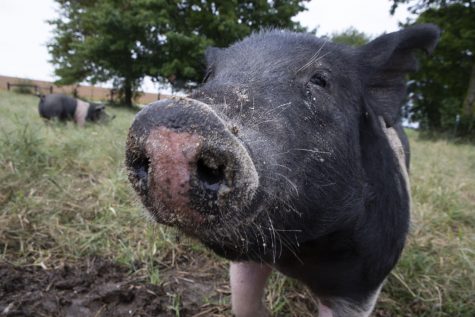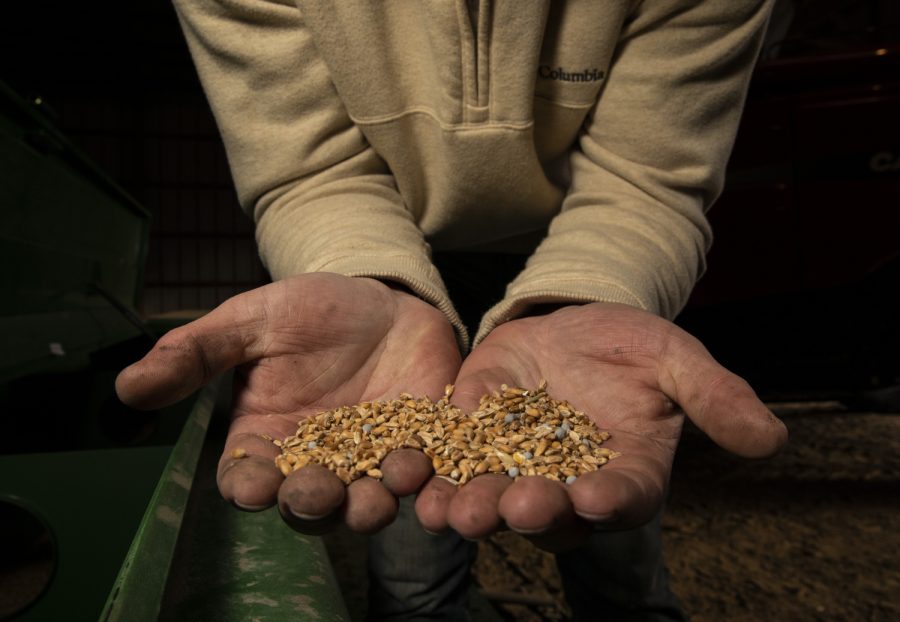Farmers face economic barriers to sustainable farming, amid climate change reports
In light of current political discourse and scientific reports about climate change, the agriculture sector has been under public scrutiny for its role in contributing to warming temperatures, but not all farmers can afford to fix it.
Mitchell Hora grows corn and soybeans in Washington County on a farm his family has owned for 115 years. He started planting cover crops four years ago and just recently started seeing economic progress after losing $100 an acre in his first year.
“In order to survive and play in this game, you have to be maximizing yield and minimize your influx,” Hora said. “And that’s how you survive in the world of ag right now, which is not good.”
Iowa farmers are under public scrutiny for their role in contributing to the changing climate because of recent political discourse, but are facing economic barriers in implementing solutions such as cover crops to reduce greenhouse gas emissions and keep carbon in the soil. In light of the 2020 presidential election and recent environmental reports from the United Nations and U.S. Department of Agriculture, climate change has consumed political conversations.

Farmer and Agricultural Consultant Mitchell Hora holds a tillage radish near his field on Oct. 11. Radishes are one of several cover crops planted to promote soil health in Hora’s fields.
Hora said he does his best to farm sustainably and understands his responsibility to be a steward of the land. He said the term “climate change” comes with a lot of political baggage that also turns off farmers because of partisan controversy, but said most in agriculture still understand their role in the environment.
Many Democratic presidential hopefuls, such as Vermont independent Sen. Bernie Sanders and South Bend, Indiana, Mayor Pete Buttigieg, have announced policies that would invest substantially more money in helping farmers implement regenerative systems in addition to existing subsidy programs. Massachusetts Sen. Elizabeth Warren does not plan to add additional subsidies and instead would reduce overproduction and change cost-share programs to benefit the farmers doing environmental conservation.
Former Vice President Joe Biden’s plan would expand existing programs with full federal funding, such as the Conservation Stewardship program, which would make payments to farmers who are sequestering carbon. California Sen. Kamala Harris’ plan would publicly invest more in assistance programs and would work with the USDA to integrate more sustainable farming practices. Harris’ plan does not give a dollar amount.
Hora said he doesn’t think investing more money is the answer; rather, there should be policies that would educate farmers on how to farm more sustainably, because he said many just simply don’t know how.
“So I want to stress that climate has become politicized like crazy … and it’s going to wreck this whole system,” Hora said. “It’s going to completely undo any kind of [environmental] progress if it continues to go down the path of being politicized.”
The purpose of cover crops is to prevent soil erosion, reduce the usage of pesticides and herbicides, and conserve soil moisture to protect overall water quality. It also helps to improve the resiliency of the soil. Planting cover crops helps to keep carbon in the soil, therefore reducing the amount of greenhouse gas emissions into the air, a major factor to the changing climate.
According to a 2017 study from Iowa State University, a mere 4 percent of farmers in Iowa use cover crops. There are government cost-share programs, but the return on investment even with government assistance will most likely still edge into the red, according to the study.
Nationally, about seven in ten Americans think global warming is happening and more than half of Americans think global warming is mostly human-caused, according to studies from Yale University and George Mason University. In Iowa, seven in 10 Iowa voters support government action that would address climate change, and nearly three-quarters of Iowans think climate change is having an effect on agriculture.
The state of Iowa has tried to take action to reduce agricultural runoff. Iowa Gov. Kim Reynolds, a Republican, has carried on Iowa’s Nutrient Reduction Strategy implemented in 2013 in an effort to reduce nitrate runoff, and part of that strategy includes increasing the acres of cover crops to 12.5 million acres. In 2017, the acres of cover crops had an approximate 22 percent increase, amounting to 760,000 acres — much lower than Reynolds’ goal.
The United Nations Intergovernmental Panel on Climate Change released a lengthy and detailed report in August on how land management is a leading contributor to climate change. Part of the report states that the agriculture and land use sectors have accounted for 23 percent of greenhouse gas emissions in the last decade. According to the report, measures such as cover cropping and adopting a variety of livestock and agroforestry practices could drastically reduce carbon emissions and reduce land degradation.
The report also says that climate change has created extreme weather events globally, such as droughts, floods, and heavy rainfall, which makes producing food difficult. It says the most vulnerable communities such as coastal regions in developing countries will be the most affected if the climate continues to get warmer.
ISU Associate Professor Alejandro Plastina, an expert in agricultural and natural resource economics, said government cost-share programs are effective incentives for farmers to begin trying cover crops, but unless that farmer also invests in something such as livestock to improve soil health, farmers will almost always lose money on an annual basis.
Once you take into account costs of seed, planting, and herbicide termination, Plastina said, farmers are likely to experience net loss and see a drop in the net cash outflow after planting cover crops.

Corn stalks line the rows of a field near Ainsworth, Iowa, on Oct. 11. The field is owned by Farmer Mitchell Hora, who uses cover crop and no-till practices.
In 2017, the Center for Agriculture and Rural Development at ISU surveyed approximately 600 farmers and found most were very interested in sequestering nitrogen, an outcome of planting cover crops, but those same people were hesitant to change the way they manage their farms, Plastina said.
“Well, the fact that there’s less than 4 percent of Iowa cropland in cover crops, is a clear indication that cover crops are not working from an economic point of view for farmers,” Plastina said. “Now, [cover crops] have benefits for society, plenty of benefits for the environment, but the problem is that the farmer is not able to capture those benefits, those externalities.”
Plastina said it’s possible in some circumstances for farmers to turn a profit quickly with cover crops, but that most have to be willing to make a long term investment in improving their soil health. This can be difficult, he said, because there’s no market for soil health — farmland is not traded on soil, but rather acreage.
Hora said he thinks the current national and state governments are moving in the right direction in terms of helping farmers farm more sustainably, but did not comment on who he voted for in 2016 or who he plans to vote for in 2020. He said it’s crucial that the issue of environmental reform becomes more of a nonpartisan issue.
“The farmers realize the impact that they’re having on the environment. They realize, like, ‘OK, I need to continue to do things better,’ ” Hora said. “But what they’re using on their farm is what they believe to be the best system to farm [with] the way that economic systems are set up.”
The USDA released a report this summer that outlined the dangers climate change will continue to have on food production. The report says if carbon emissions and rainfall continue to increase, all production systems will be affected to some degree. It also says that agriculture is dependent on the ecosystem to support productivity, and the changes in climate will compromise that support. Climate change will also hurt pollinator life cycles, which will ultimately reduce yields.

One of the Biermans’ pigs walks around land they share with neighbors outside Tipton, Iowa on Sunday, October 6, 2019. Jamie Bierman said it’s hard not to smile when the pigs come out to greet her.
Steve Berger, a farmer in Washington County, does not think climate change is manmade, but planted his first cover crop in 1978 in an effort to better his farm’s soil health and protect water quality of surrounding bodies of water. Berger said he didn’t face the same economic barriers as farmers who are beginning to plant cover crops now.
There is overwhelming evidence and a scientific consensus that climate change is human-caused. According to a report from NASA, there is more than a 95 percent chance that the current warming trend has been because of human activity since the mid-19th Century. It also said 97 percent of climate scientists agree that global warming trends over the last century are extremely likely due to human activity.
Berger said farmers are more likely to farm sustainably because of economic incentives than the changing climate.
“From the standpint of climate change, I don’t think anybody really agrees that there’s a problem,” Berger said. “You know, I mean, I’m sure you can find somebody who thinks it is a problem, but you have to scientifically prove that and so far, they haven’t really scientifically proven that.”
Berger cited a report from U.S. House Rep. Mo Brooks, R-Alabama, that stated a panel of scientists said humans did not cause the past 20,000 years of global warming. Brooks’ summary of the hearing mischaracterized the scientists statements by leaving out points in which the panel did say humans are responsible for the last 100 years of the changing climate.
“So, I would agree that when it began 20,000 years ago when we were coming out of the last glacial, that was not caused by humans,” said research scientist Twila A. Moon, according to the transcript. “The warming of the last 100 years, most certainly was.”
Berger said he thinks the government is currently doing an adequate job of making sure farmers are able to farm sustainability. He said the bottom line in planting cover crops is to ensure soil health and to lessen nitrate pollution in surrounding rivers that feed into the Gulf of Mexico.
Jamie and Cory Bierman have run a completely regenerative farm in southwest Johnson County for about six years. They have three daughters who are also passionate about sustainable farming, Cory said, and help with farm chores and taking care of the cattle. On their 600-acre farm, they raise cows, pigs, chickens, turkeys, and goats.
“If you’re regenerating something, you’re trying to put it back to its original state, or better,” Jamie said. “And so every animal has that ability to do that, but it usually has to work with another animal.”
She said allowing the cows and chickens to graze makes the grass grow back thicker. Damaged grass naturally regenerates healthier than if you were to plant grass, she said, noting this system allows them to keep double the amount of animals per acre, which increases their profitability. She also said chickens eat the larvae in cow manure.

Jamie Bierman moves one of two chicken coops on her family’s farm outside Tipton, Iowa on Sunday, October 6, 2019. Bierman said each coop holds about 100 chickens, and moving them around helps maintain the quality of the grass they eat.
Another benefit of keeping cattle on large plots of healthy grass, she said, is that it reduces the risk for water runoff. They don’t keep their cows in concentrated, dry-lot areas, so rainfall helps in capturing carbon from the air because the rain is able to pull manure into the ground. Keeping cows on large pastures also helps to reduce soil erosion and allows beneficial organisms to live in the soil. This is also true for pigs, because they help to turn manure into dirt.
“I’m not a climate expert,” Jamie said. “I do believe that we probably do have more carbon in the air now than we did even 100 years ago.” She later added that she does think a part of the climate crisis is manmade, but said there’s a possibility the Earth would have followed these weather patterns anyway, so she can’t be sure exactly how or why climate change is happening.
According to NASA, the Earth’s surface temperature has increased about 1.62 degrees Fahrenheit since the late 19th Century. This change was driven by an increase in carbon dioxide and other human-caused gas emissions in the atmosphere.
The Biermans partner with their neighbors who farm corn and soybeans. The Biermans sell them manure to fertilize their fields, and in return their neighbors allow their livestock and cattle to graze their fields, which helps save the Biermans money on feed. When cattle and livestock graze on grassland plants, those plants release more energy into the ground in order to regrow, which greatly helps increase the soil health of that field. This also helps to ensure successful crop rotations.
The Biermans said there is a stigma around changing traditional farming habits to becoming more organic and regenerative. When generations of farmers have farmed a certain way, Cory said, it can be difficult for people to change what their family has been doing for years. He added that the current political climate also makes it difficult to navigate conversations about sustainability with farmers.
Cory said education about why sustainable farming is so important, and education on how it can be done, will be the only way to push other people to change their practices.
“We’d be happy if one person changed one thing,” Cory said. “It’s like dragging a freight train up a hill.”
Editor’s note: a previous version of this story incorrectly reported that one in seven Americans think global warming is happening. The Yale study cited wrote that seven in ten Americans think global warming is happening. The DI regrets the error.



